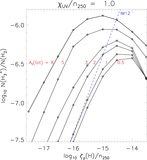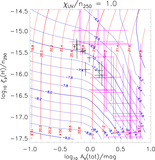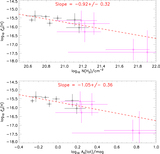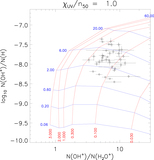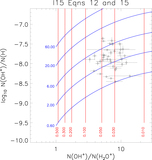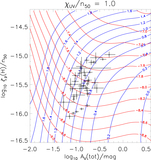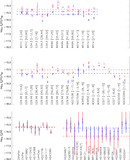Image Details
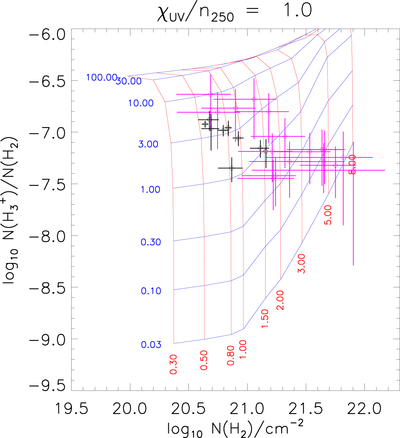
Caption: Figure 3.
H2 column densities and ﹩N({{\rm{H}}}_{3}^{+})/N({{\rm{H}}}_{2})﹩ column density ratios predicted for diffuse and translucent molecular clouds with ﹩{\chi }_{\mathrm{UV}}/{n}_{250}=1﹩, where ﹩{\chi }_{\mathrm{UV}}﹩ is the incident radiation field in Draine (1978) units and ﹩{n}_{{\rm{H}}}=250\,{n}_{250}\,{\mathrm{cm}}^{-3}﹩ is the density of H nuclei. Results are shown in the plane of ﹩N({{\rm{H}}}_{2})﹩ and ﹩N({{\rm{H}}}_{3}^{+})/N({{\rm{H}}}_{2})﹩, with contours of visual extinction, ﹩{A}_{{\rm{V}}}(\mathrm{tot})﹩, shown in red and contours of ﹩{\zeta }_{p}({\rm{H}})/{n}_{250}﹩ shown in blue (where ﹩{\zeta }_{p}({\rm{H}})\sim {\zeta }_{t}({{\rm{H}}}_{2})/2.3﹩ is the primary CRIR per H nucleus and ﹩{\zeta }_{t}({{\rm{H}}}_{2})﹩ is the total CRIR per H2 molecule). Blue contours are labeled with ﹩{\zeta }_{p}({\rm{H}})/{n}_{250}﹩, in units of ﹩{10}^{-16}\,{{\rm{s}}}^{-1}﹩, and red contours with ﹩{A}_{{\rm{V}}}(\mathrm{tot})﹩ in mag. Diamonds, with 1σ error bars, indicate measurements reported by IM12 or Albertsson et al. (2014). Here, black diamonds denote measurements obtained from direct observations of H2, and magenta diamonds show cases in which the H2 column densities have been inferred indirectly from observations of CH or ﹩E(B-V)﹩.
Copyright and Terms & Conditions
© 2017. The American Astronomical Society. All rights reserved.



